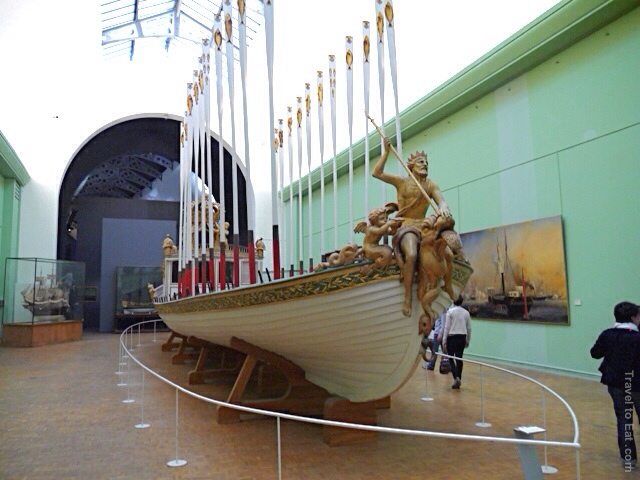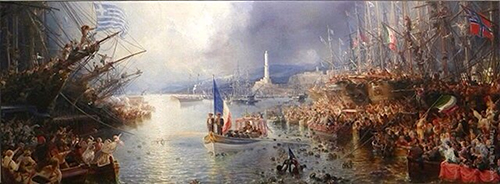
If you are visiting the Eiffel tower and looking for something else to do, you might consider the French Maritime Museum at the Trocadero, the largest in the world. Apart from Napoleon’s canot, seen below, another striking feature in the first room at the Paris Musée de la Marine is the painting of the arrival of Napoleon III at Gênes in 1859, by Théodore Gudin seen above.
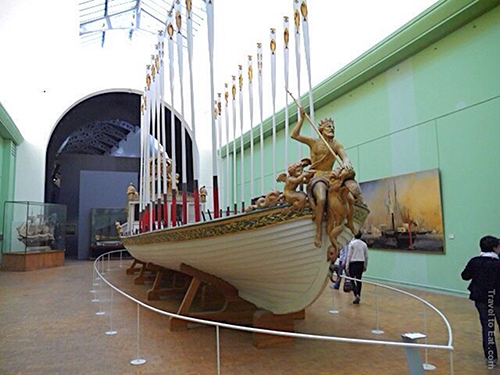
In 1748, Henri-Louis Duhamel du Monceau offered a collection of models of ships and naval installations to Louis XV of France, with the request that the items be displayed at the Louvre and made available to students of the Naval engineers school, which Duhamel headed. The collection was put on display in 1752, in a room of the first floor, next to the Academy of Sciences; the room was called “Salle de Marine” (Navy room), and was used for teaching. King Charles X decided to create the maritime museum in 1827, which he named the Musée Dauphin but after 1830 the name was changed to what we know it as today, the Musée de Marine.
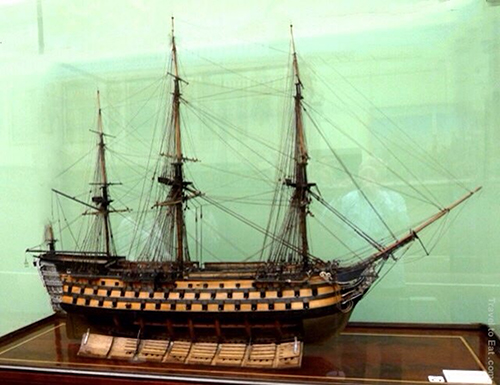
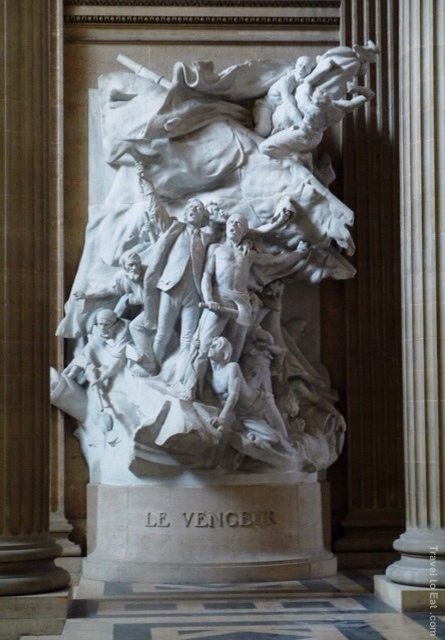
They have a model ship in the front lobby of historical significance, the one pictured above, the French ship Ocean (1890). As the largest ship of the line in the Brest fleet, the ship spent much of her early career as the fleet flagship. As the Montagne, the ship was the flagship of Rear-Admiral Villaret-Joyeuse in the Combat de Prairial (in England, Glorious First of June) in 1794, protecting a convoy of food from America. I wrote about this battle in my post on the French Parthenon. She was badly damaged by the HMS Royal Sovereign, losing 313 men and receiving 233 round shots in her hull. The Vengeur was sunk in the same battle and became a rallying cry for the French Revolution.
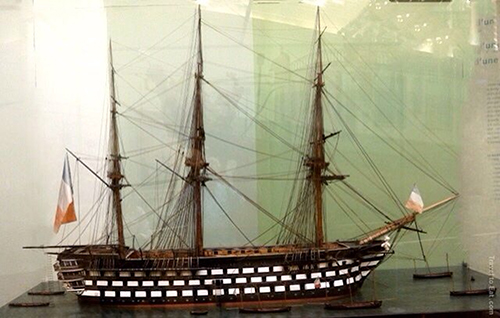
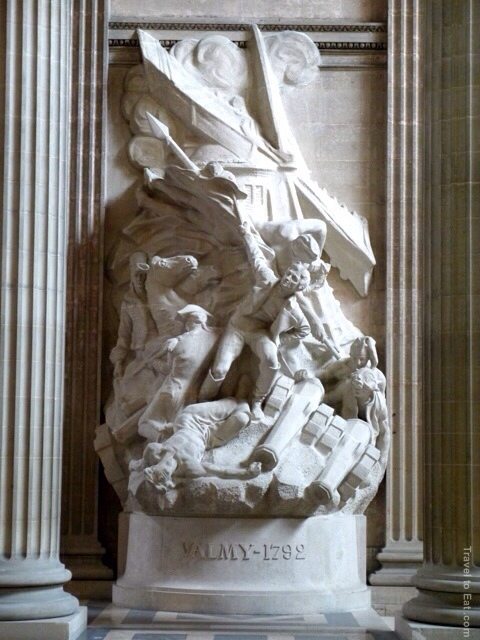
Valmy, named after the Battle of Valmy, was the largest three-decker of the French Navy, and the largest tall ship ever built in France. When she entered service in 1849, she was the largest warship in the world and would remain so until 1853. Valmy was thought to be the largest sort of sailing ship possible, as larger dimensions made the management of rigging impracticable with mere manpower. She was engaged in the Crimean War, where she proved difficult to maneuver and, like other sailing vessels, often had to be towed by steam ships.
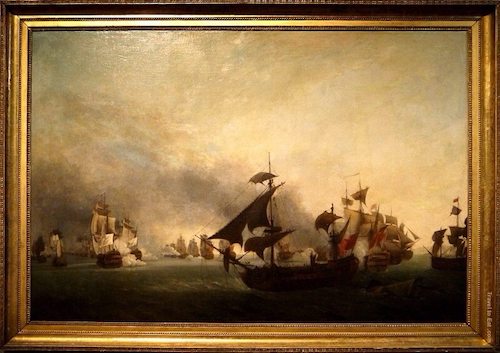
This is a painting by Jean-François Hue depicting the naval battle Grenada July 2, 1779 in the West Indies between France and Britain. Naval historian Alfred Thayer Mahan described the British loss as “the most disastrous … that the British Navy had encountered since Beachy Head, in 1690.”
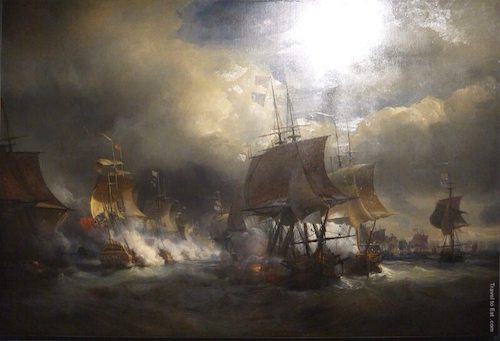
The Battle of Ushant seen above by Théodore Gudin (1848), took place on 27 July 1778, fought between French and British fleets 100 miles (160 km) west of Ushant, a French island at the mouth of the English Channel off the north-westernmost point of France. The battle ended indecisively and led to political disputes in both countries. The subsequent battle of Ushant in 1781 began the first of a succession of Opposition challenges which would ultimately bring about the fall of the government of Lord North on 20 March 1782 and pave the way for the Peace of Paris (1783), which ended the American Revolutionary War.
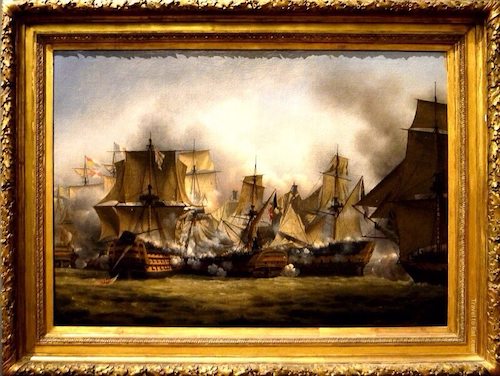
The painting shown above is by Louis-Philippe Crépin (1807) shows a distinctly French view of Victory and Redoutable at Trafalgar, with a sharp-shooter aloft in Redoutable in the act of killing Vice-Admiral Lord Nelson, and the battle ensign of Victory (ship to the left) trailing in the water from a severed mast. The Battle of Trafalgar (21 October 1805) was a naval engagement fought by the British Royal Navy against the combined fleets of the French Navy and Spanish Navy, during the Napoleonic Wars (1803–1815). The British victory spectacularly confirmed the naval supremacy that Britain had established during the previous century. About the only bright spot for France was that Admiral Lord Nelson was hit and killed by a marksman from the Redoutable, firing at a range of 50 feet. Redoubtable engaged the British Flagship Victory and after a fierce battle, with Captain Lucas severely wounded, and only 99 men still fit out of 643 (300 dead and 222 severely wounded), was essentially defenseless. She sank the next day.
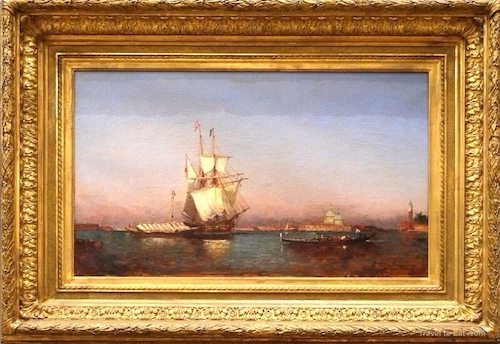
I just included this painting by Paul Emmanuel Gallard-Lepinay of the Voiler entering the grand canal in Venice from 1880. I think it is a beautiful painting. One of his works sold for 1.6 million dollars in 2011.
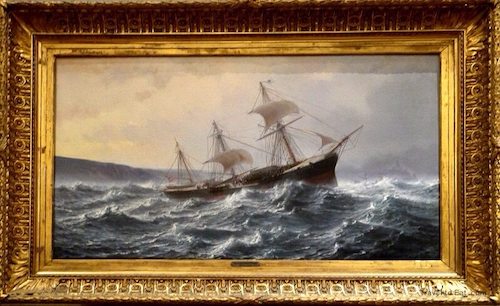
Jean-Baptiste Henri Durand-Brager, a French marine painter, was born at Dol in 1814. He studied under Gudin and Eugène Isabey, and in 1840 accompanied the fleet which brought Napoleon’s remains from St. Helena, which island afforded him subjects for various pictures. He is known for these “rough sea” paintings. In 2010 one of his works sold for 3 million dollars.


They also have a really interesting collection of oddities like this 8 foot elaborately carved wooden tiller seen above. The other end, seen in the bottom picture above, shows a hunting scene in some tropical locale with palm trees.
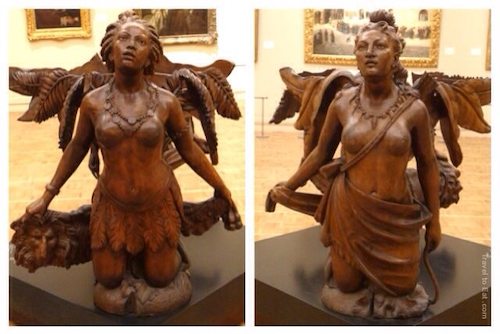
Everywhere you turn there are exceptional wood carvings like this set of “table legs” done for the museum by Victor in 1896 titled Africa and America. (it must have been some table)
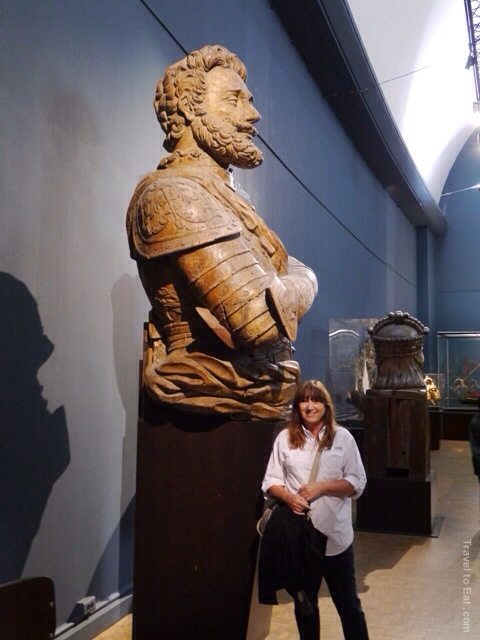
They have a collection of giant statues for the prows of ships, like this one for King Henry IV. One of the most popular French kings, both during and after his reign, Henry showed great care for the welfare of his subjects and displayed an unusual religious tolerance for the time. He enacted the Edict of Nantes, in 1598, which guaranteed religious liberties to the Protestants, thereby effectively ending the civil war. In 1854 the ship Henry IV wrecked off the coast of Crimea where the figurehead was miraculously recovered.
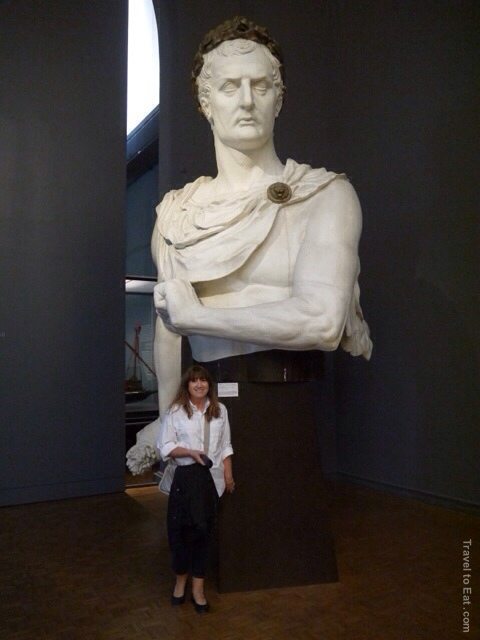
This is a bust of Napoleon I which was on the prow of the ship Iena, carved in 1846 (Jena in English) based on the victory of Napoleon I over the Prussians in 1806. The twin battles of Jena and Auerstedt were fought on 14 October 1806 on the plateau west of the river Saale in today’s Germany, between the forces of Napoleon I of France and Frederick William III of Prussia. The decisive defeat suffered by the Prussian Army subjugated the Kingdom of Prussia to the French Empire until the Sixth Coalition was formed in 1812. Nopoleon built the bridge Iena in Paris to commemorate this victory.
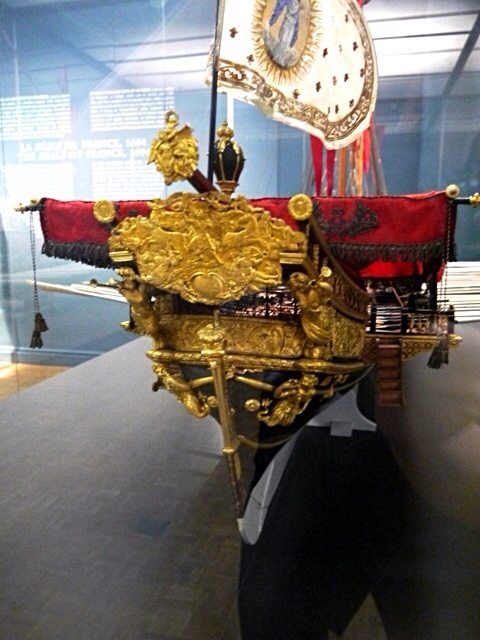
And this model ship, the galley La Minerva from 1746, done in exquisite detail at 1/25 scale. Beside this beautiful little model are the full size carvings from the actual ship on a steel frame mockup.
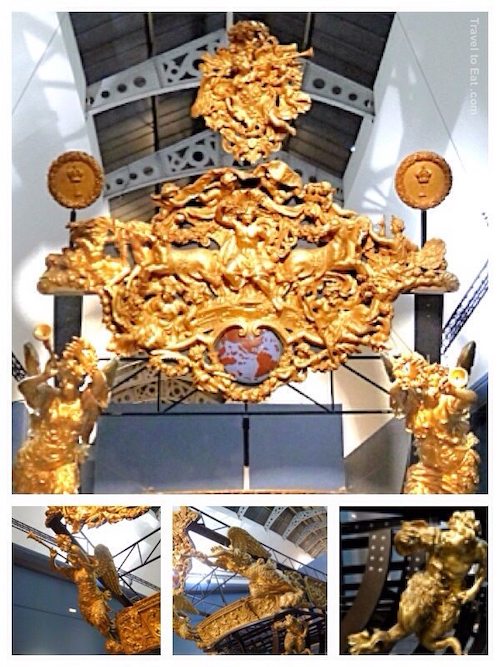
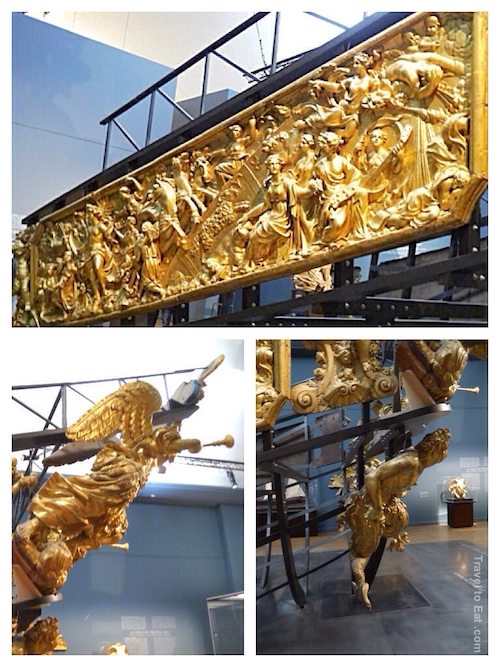
The top set comes from the back of the ship, the stern, while the bottom set come from the prow.
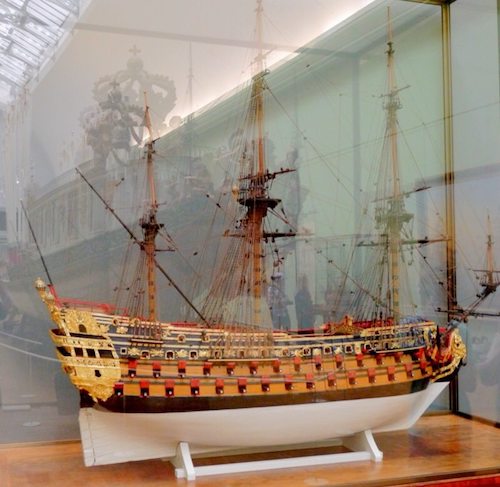
This model, Le Louis Quinze, was used for the naval education of the future Louis XV. It is done in 1/36 scale and dated 1720-1725. This model does not represent an actual ship, being created for education. The workmanship of the model is pretty amazing though.
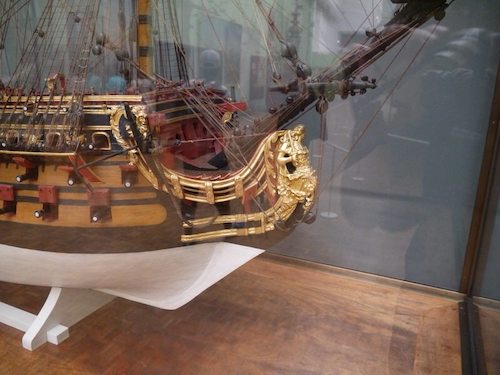
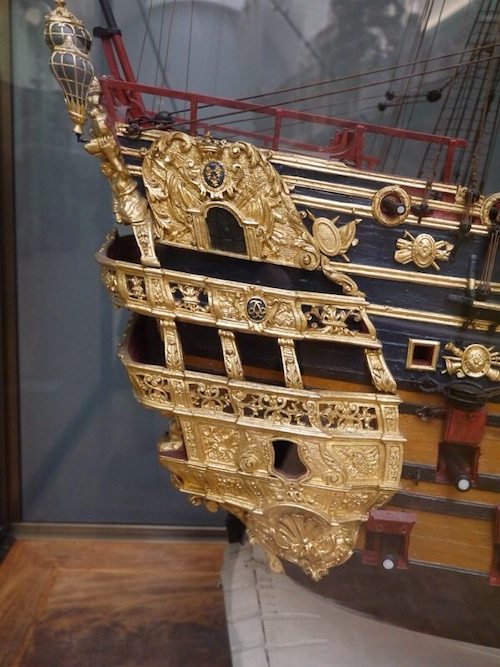
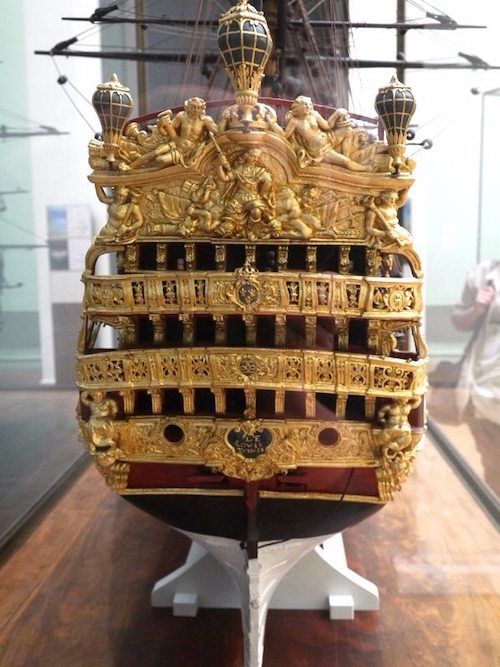
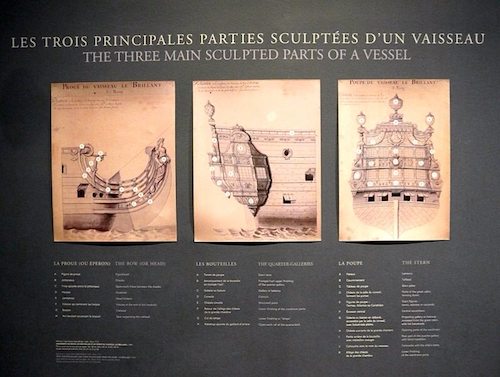
The decorations follow the basic plans for sculpted parts of the ship, the prow, the quarter deck and the stern. This ship looks a lot like Le Brilliant from 1690.
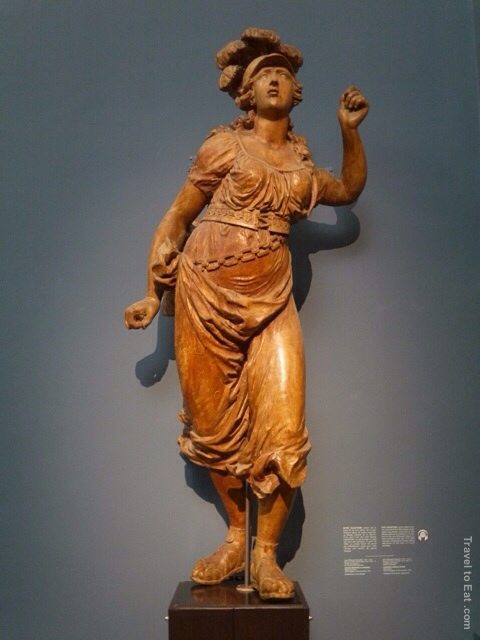
This is one of the earliest full length carvings in the collection, dating to the end of the 17th century. From 1824 on, a bust was used instead of a full length portrait on the prow.
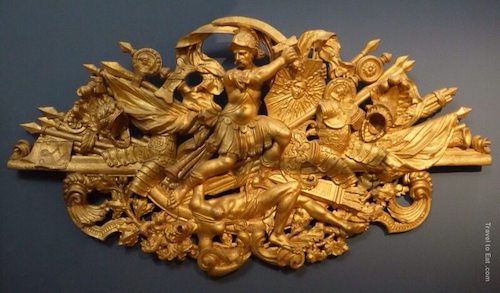
This is high relief stern plate showing Perseus slaying Medusa, done during the reign of Louis XIV. The “sun king” is shown on the shield.
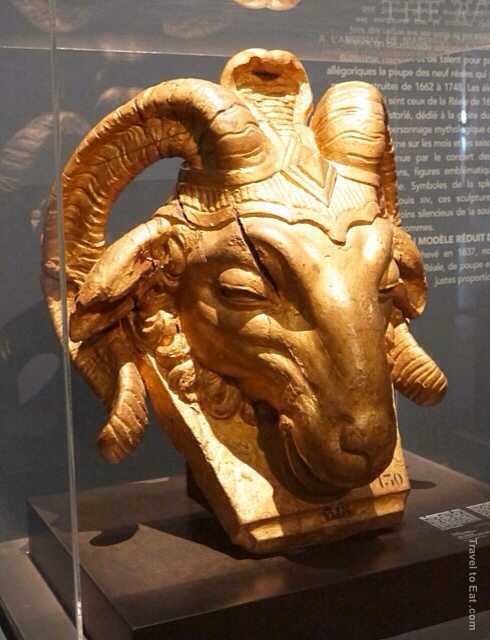
Removable statue of a rams head used during festivals.
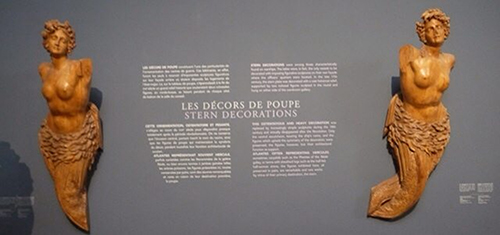
All this decoration was replaced by increasingly natural decoration during the 18th century and virtually disappeared during the revolution.
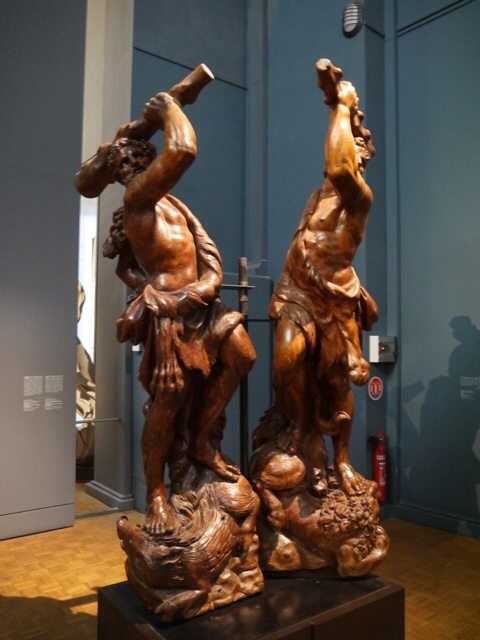
Here is a set of naturalistic ship statutes that are frankly amazing to observe.
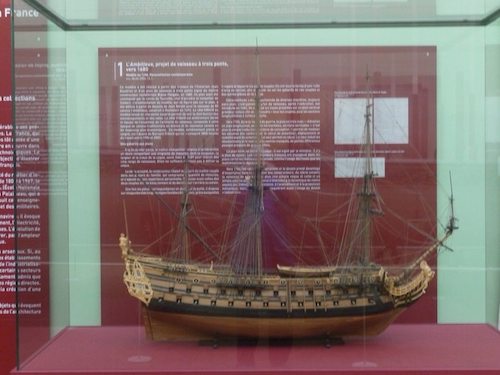
In 1680 the Chevalier de Tourville pressed the French Navy to construct a ship of 80 guns made to a design by the naval architect Blaise Panglano. The idea was rejected by the Minister of the Marine M. de Colbert, who thought the ship was too large and expensive for 80 guns. The advantage of Paglano’s design was stability, but this was ignored by M. de Colbert. Panglano was to be vindicated later, as shipwrights soon adopted his ideas and incorporated them into their designs a decade later. Paglano’s original design was never built, but his plans still exist and became the basis of Jean Boudriot’s recent monograph entitled “Le trois-ponts du chevalier de Tourville“. Boudriot has given M. Paglano’s ship the appropriate name “L’Ambitieux” (The Ambitious). This model was built from the plans.
There is a lot more to see at the French Maritime Museum but I think this is a place you should definitely visit. Convenient location, no long lines, great paintings, sculpture, ships, nautical equipment and exhibits, it has something for everyone.

